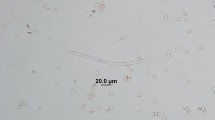Abstract
Feline demodicosis is a rare parasitic condition caused by three different species of mites (Demodex cati, Demodex gatoi, and an unnamed species). D. gatoi inhabits the superficial skin layer (stratum corneum) and is easily transmitted between individual cats. A 2-year-old female spayed Cornish Rex was presented with alopecia and pruritus. The dermatological examination revealed bilateral alopecia and excoriations on trunk, limbs, and belly. The second cat in the household, a 3-year-old female spayed Thai, showed no clinical signs. Superficial and deep skin scrapings were performed and cellophane tapes applied, and living D. gatoi mites could be detected in both cats. Oral ivermectin (0.25 mg/kg every other day) was subscribed. Feces were collected from both cats and fecal flotation with sugar and zinc solutions performed. When compared to skin scrapings and cellophane tapes, D. gatoi was detected more frequently and in higher numbers in fecal samples. Our findings suggest that D. gatoi can be efficiently diagnosed with coproscopy, particularly in asymptomatic carrier animals. DNA was extracted from the flotation liquid, and a PCR protocol for the species verification was designed. A fragment targeting a 325-bp DNA fragment of the D. gatoi mitochondrial 16S rDNA gene was amplified with a 100 % similarity to the D. gatoi entry in GenBank® (GI 421920216). We report the first finding of D. gatoi in Austria and propose fecal flotation as a valuable tool for mite detection. Fecal flotation liquid is suitable for DNA extraction and PCR-based species verification of D. gatoi.





Similar content being viewed by others
References
Beale K (2012) Feline demodicosis: a consideration in the itchy or overgrooming cat. J Feline Med Surg 14(3):209–213
Chesney CJ (1999) Short form of Demodex species mite in the dog: occurrence and measurements. J Small Anim Pract 40(2):58–61
Chesney CJ (1988) An unusual species of Demodex mite in a cat. Vet Rec 123 (26–27):671–673
de Rojas M, Riazzo C, Callejon R, Guevara D, Cutillas C (2012) Molecular study on three morphotypes of Demodex mites (Acarina: Demodicidae) from dogs. Parasitol Res 111(5):2165–2172
Desch CE Jr, Stewart TB (1999) Demodex gatoi: new species of hair follicle mite (Acari: Demodecidae) from the domestic cat (Carnivora: Felidae). J Med Entomol 36(2):167–170
Filler S, Alhaddad H, Gandolfi B, Kurushima JD, Cortes A, Veit C, Lyons LA, Brem G (2012) Selkirk Rex: morphological and genetic characterization of a new cat breed. J Hered 103(5):727–733
Ghubash R (2006) Parasitic miticidal therapy. Clin Tech Small Anim Pract 21(3):135–144
Griffin CE (2012) Fleas and other little critters, ectoparasites in cats. British Veterinary Dermatology Study Group 13
Guaguere E, Muller A, Degorce-Rubiales F (2004) Feline demodicosis: a retrospective study of 12 cases. Vet Dermatol 15:34
Kano R, Hyuga A, Matsumoto J, Nogami S, Nemoto S, Hasegawa A, Kamata H (2012) Feline demodicosis caused by an unnamed species. Res Vet Sci 92(2):257–258
Löwenstein C, Beck W, Bessmann K, Mueller RS (2005) Feline demodicosis caused by concurrent infestation with Demodex cati and an unnamed species of mite. Vet Rec 157(10):290–292
Morris DO (1996) Contagious demodicosis in three cats residing in a common household. J Am Anim Hosp Assoc 32(4):350–352
Mueller RS (2004) Treatment protocols for demodicosis: an evidence-based review. Vet Dermatol 15(2):75–89
Neel JA, Tarigo J, Tater KC, Grindem CB (2007) Deep and superficial skin scrapings from a feline immunodeficiency virus-positive cat. Vet Clin Pathol 36(1):101–104
Paterson S (2006) Skin diseases of exotic pets, 1st edn. Blackwell Science., Oxford
Ravera I, Altet L, Francino O, Bardagí M, Sánchez A, Ferrer L (2011) Development of a real-time PCR to detect Demodex canis DNA in different tissue samples. Parasitol Res 108:305–308
Reitemeyer S, Kohn B (2002) Demodicosis in the cat. Praktischer Tierarzt 83(7):594–596
Saari SA, Juuti KH, Palojarvi JH, Vaisanen KM, Rajaniemi RL, Saijonmaa-Koulumies LE (2009) Demodex gatoi-associated contagious pruritic dermatosis in cats—a report from six households in Finland. Acta Vet Scand 51:40
Sastre N, Ravera I, Villanueva S, Altet L, Bardagi M, Sanchez A, Francino O, Ferrer L (2012) Phylogenetic relationships in three species of canine Demodex mite based on partial sequences of mitochondrial 16S rDNA. Vet Dermatol 23(6):509–e101
Zhao YE, Wu LP (2012) Phylogenetic relationships in Demodex mites (Acari: Demodicidae) based on mitochondrial 16S rDNA partial sequences. Parasitol Res 111(3):1113–1121
Zhao YE, Wu LP, Hu L, Xu Y, Wang ZH, Liu WY (2012) Sequencing for complete rDNA sequences (18S, ITS1, 5.8S, ITS2, and 28S rDNA) of Demodex and phylogenetic analysis of Acari based on 18S and 28S rDNA. Parasitol Res 111(5):2109–2114
Acknowledgments
The authors wish to thank Barbara Eigner, Walpurga Wille-Piazzai, and Radinka Selista for technical support.
Conflict of interest
The authors declare no conflict of interest.
Author information
Authors and Affiliations
Corresponding author
Rights and permissions
About this article
Cite this article
Silbermayr, K., Joachim, A., Litschauer, B. et al. The first case of Demodex gatoi in Austria, detected with fecal flotation. Parasitol Res 112, 2805–2810 (2013). https://doi.org/10.1007/s00436-013-3448-6
Received:
Accepted:
Published:
Issue Date:
DOI: https://doi.org/10.1007/s00436-013-3448-6




